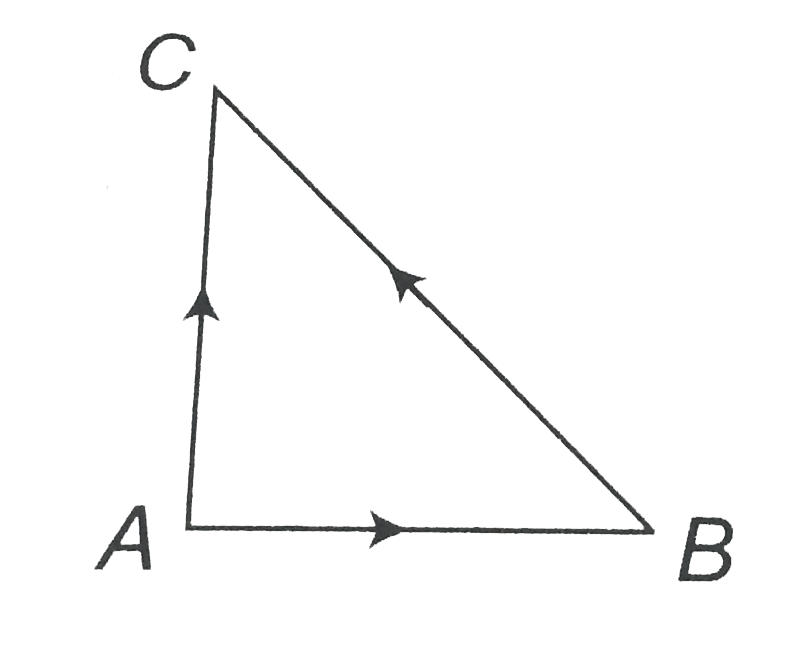Three forces start acting simultaneously on a particle moving with velocity v. These forces are represented in magnitude and direction by the three sides of a triangle ABC (as shown). The particle will now move with velocity:

→v (remaining unchanged)
less than →v
greater than →v
→v in the direction of the largest force BC
The correct Answer is:a
Given three forces are in equilibrium i.e. net force will be zero. It means the particle will move with same velocity.
Topper's Solved these Questions
- BOOK - CENGAGE PHYSICSCHAPTER - STATICSEXERCISE - MANDATORY EXERCISE SET III12videos
STATICS
- BOOK - CENGAGE PHYSICSCHAPTER - STATICSEXERCISE - MANDATORY EXERCISE8videos
STATICS
- BOOK - CENGAGE PHYSICSCHAPTER - STATICSEXERCISE - MANDATORY EXERCISE (NUMERICALS)5videos
STATICS
- BOOK - CENGAGE PHYSICSCHAPTER - SOUNDEXERCISE - OLYMPIAD AND NTSE LEVEL EXERCISE10videos
SOUND
- BOOK - CENGAGE PHYSICSCHAPTER - UNITS AND MEASUREMENTEXERCISE - OLYMPIAD AND NTSE LEVEL EXERCISES8videos
UNITS AND MEASUREMENT
Similar Questions
Three forces start acting simultaneously on a particle moving with velocity →v. These forces are represented in magnitude and direction by the three sides os a triangle ABC (as shown). The particle will now move with velocity.
 View Solution
View SolutionThree forces start acting simultaneously on a particle moving with velocity, →v. These forces are respresented in magnitude and direction by the three sides of a triangle ABC. The particle will now move with velocity
 View Solution
View Solution
Knowledge Check
- Question 1 - Select One
Three forces start acting simultaneously on a particle moving the velocity →V. The forces are represented in magnitude and direction by the three sides of a triangle ABC (as shown). The particle will now move with velocity
 Aless than →VBgreater than →VC∣∣→V∣∣ in the direction of largest forceD→V remaining unchanged
Aless than →VBgreater than →VC∣∣→V∣∣ in the direction of largest forceD→V remaining unchanged - Question 2 - Select One
Three forces start acting simultaneously on a particle moving with velocity, ¯v. These forces are respresented in magnitude and direction by the three sides of a triangle ABC. The particle will now move with velocity
 A→v remaining unchangedBless than →vCgreater than →vD→v in the direction of the largest force BC
A→v remaining unchangedBless than →vCgreater than →vD→v in the direction of the largest force BC - Question 3 - Select One
Three forces start acting simultaneously on a particle moving with velocity, ¯v. These forces are respresented in magnitude and direction by the three sides of a triangle ABC. The particle will now move with velocity
 A(a) less than →vB(b) greater than →vC(c) |v| in the direction of the largest force BcD(d) →v, remaining unchanged
A(a) less than →vB(b) greater than →vC(c) |v| in the direction of the largest force BcD(d) →v, remaining unchanged
Three forcesstart acting simultaneously on a particle moving with a velocity →v . These forces are represented in magnitude and direction by three sides of a triangle taken in the same order. What now will be the velocity of the particle ?
View SolutionIf an α− particle moving with velocity 'v' enters perpendicular to a magnetic field then the magnetic force acting on it will be-
View SolutionWrite the expression for the magnetic force acting on a, charged particle moving with velocity v in the presence of magnetic field B.
View SolutionP,Q and R are three forces acting simultaneously on a particle .→S is the vector sum, of the three forces show that if →S = 0 , the vector representing these forces form a triangle.
View SolutionThe force acting on a particle of charge q moving in a uniform magnets field with velocity v is
View Solution
